|
Styles époques
THE HISTORY OF ART DECO
|
Cet article se compose de 7 pages.
 1
2
3
4
5
6
7
1
2
3
4
5
6
7

|
The term «Art Deco» was first used in the 1960's and not in the 1920's at a time when collectors showed a keen interest in the objects, glass works and furniture designed between the two world wars.
Art Deco lovers have now been numerous throughout the world and auction sales as well as reference books have been multiplying in the past ten years.
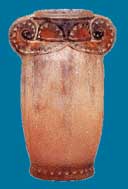
Gabriel Argy Rousseau,
ovoïd vase "Thebes" glass
What is fashionable today has much to do with Art Nouveau and Deco stuff because both styles do marry well with modern trends.
Truly, the designers of the early years of this Century were much inventive and creative. They did not hesitate to turn their backs to the heavy 19th Century forms and to produce modernistic objects and furniture in line with the achievements of a new brand of architects.
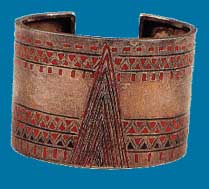
Jean Dunand, sleeve-bracelet
in silver with geometric design
Art Deco found its source directly from Art Nouveau which emerged around 1895 mostly in Austria and in France.
It must be stressed that the Austrian 1900 designers played a major part in inventing new forms, notably Josef Hoffman and Koloman Moser who created the Wiener Werkstätte after they came under the influence of Britain's William Morris or Rennie Mackintosh. The Vienna designers chose purity contrary to the French who were attracted by intricate forms.

Hermes, cigaret box in silver and silver-gilt
with geometric bands decor
|


|
The term «Art Deco» was first used in the 1960's and not in the 1920's at a time when collectors showed a keen interest in the objects, glass works and furniture designed between the two world wars.
Art Deco lovers have now been numerous throughout the world and auction sales as well as reference books have been multiplying in the past ten years.

Gabriel Argy Rousseau,
ovoïd vase "Thebes" glass
What is fashionable today has much to do with Art Nouveau and Deco stuff because both styles do marry well with modern trends.
Truly, the designers of the early years of this Century were much inventive and creative. They did not hesitate to turn their backs to the heavy 19th Century forms and to produce modernistic objects and furniture in line with the achievements of a new brand of architects.

Jean Dunand, sleeve-bracelet
in silver with geometric design
Art Deco found its source directly from Art Nouveau which emerged around 1895 mostly in Austria and in France.
It must be stressed that the Austrian 1900 designers played a major part in inventing new forms, notably Josef Hoffman and Koloman Moser who created the Wiener Werkstätte after they came under the influence of Britain's William Morris or Rennie Mackintosh. The Vienna designers chose purity contrary to the French who were attracted by intricate forms.

Hermes, cigaret box in silver and silver-gilt
with geometric bands decor
The role of Cubism was also prominent in the emergence of Art Deco and Fernand Léger was one of the exponents of the alliance between art and industry which in designing was more fully carried out in Germany. In this respect one of the best examples could be found in the film «Metropolis» which, apart from describing a cold mechanical world, contained all the decorative ingredients of those modernistic shapes which were to become rapidly fashionable throughout Europe.
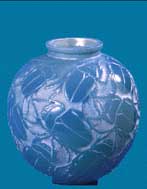
René Lalique,
"Gros scarabées",
Emerald glass vase
For the first time, the combination of art and industry was not just an ephemeral event but a steady revolution already triggered by new constructivist ideas originating from the newly-born Soviet Republic. Thus between 1917 and 1922, audacious theories were made by those artists, notably Malevitch, Tatlin, Naum Gabo and his brother Antoine Pevsner or El Lissitsky about the need to put art at the disposal of the masses. In that sense, Art Deco was not just intended for the elite - though the working class did not really have direct access to it but stylewise it did enhance many aspects of daily life mainly in big cities.
At last many artists in Moscow, Budapest, Vienna, Berlin, Munich, Brussels, London, Glasgow, Rome, Paris and Barcelona were involved in the creation of Art Deco houses, furniture, tapestries, textiles and objects. In New York meanwhile designers like Frank Lloyd Wright played a significant role in helping the development of Art Deco abroad.
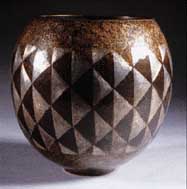
Claudius Linossier (1893-1953),
spheric red copper vase with silvered
metal geometric bands |
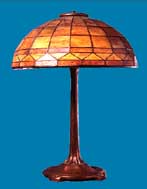
Louis-Comfort Tiffany Patinated bronze table-lamp, with American yellow glassmosaic lamp shade |
In France, many designers and artists were active in developing Art Deco stylejust after the First World War such as
Fernand Léger, the painters André Mare, Robert and Sonia Delaunay, Roger de la Fresnaye, Jacques Villon, Albert Gleizes, Jean Metzinger, Jean Lambert-Rucki, André Léveillé, Ozenfant, Raoul Dufy, Georges Lepape, Marie Laurencin, Paul Iribe, Cassandre, Tamara de Lempicka, the sculptors Bourdelle, Jean Chauvin, Henri Bouchard, Joseph Bernard, Jacques Lipchitz, Josef Csaky, the architects Auguste Perret, Patout, Dondel, Viard, Aubert, Robert Mallet-Stevens, Le Corbusier and his assistant Charlotte Pierrand, the glass manufacturers Lalique, Decorchemont, Argy Rousseau, Marinot and Colotte, several goldsmiths, silversmiths and coppersmiths, notably Fouquet, Puiforcat, R. Templier, Jean Desprès and Claudius Linossier, many furniture makers notably André Arbus, Clément Mère, René Herbst, Marcel Breuer, Jean-Michel Franck, Louis Sue, Marcel Coa rd, Paul Dupré-Lafon, André Groult, Eileen Gray, Armand Rateau, Emile-Jacques Ruhlmann, Eugène Printz, Jean
Baldovici, Edgar Brandt, Carlo Bugatti, Albert Cheuret, Francis Jourdain, Paul Follot, Jean Dunand, Jules Leleu, Pierre Legrain who was also a famous book-binder, the fashion designers Paul Poiret and Jeanne Lanvin and the art collector Jacques Doucet among many others.
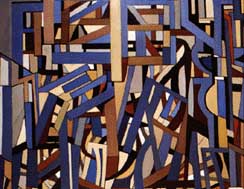
Tamara de Lempicka,
" Musicalist Composition ", oil on canvas

Louis Sue and André Mare, executed by Richard Desvallières,
Important steel console with drapery and volutes decor and marble top
There was some kind of intense rivalry between those who stuck to formal old decorative styles and the exponents of modernism who followed the development of industrial technologies.
The war had come to broaden the gap between them and to oppose old and new concepts. Dadaism came to mock old habits and Surrealism did much to cause the emergence of intellectuals. This came at a time when women were on their way to obtain more freedom, when Jazz music reached Europe, when new dances invested ball rooms, when African tribal art inspired many artists, when the industrial world was steadily wiping out an outdated way of living with its new ventures, with industrialists wanting more productivity and workers fighting for a better life, with new ideologies surging up in Germany and Italy as a result of a chain of events which went out of control.

Josef Hoffmann,
Set of wall lights |
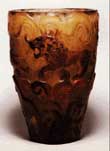
Gabriel Argy Rousseau, a beige, brown, yellow and orange pâte de verre vase of spreading cylindrical form with a frieze of three lions |
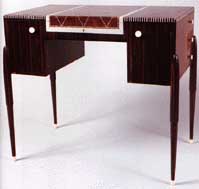
Emile-Jacques Ruhlmann (1879-1933),
Small lady Macassar ebony desk
The 1920's were truly crazy years and in less than two decades the whole world could not cope with extraordinary disturbing changes. This led to disaster in 1940 but in this context Art Deco was not really blameable for this.
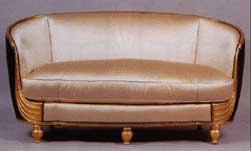
Paul Follot (1877-1941),
Gilt-wood couch covered with cream silk
Such form of art, just like Art Nouveau previously, was simply part of the spirit of that time and was just there to accompany a change of civilisation just like the swinging 1960's did.
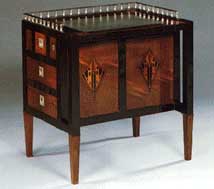
Josef Hoffmann (1870-1956),
A desk inlaid with various woods
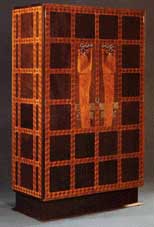
Koloman Moser (1868-1918),
important cabinet with inlaid figures from a suite
of bedroom furniture with geometric marquetry in exotic
woods and metal and mother-of-pearl inlay
The 1920's were truly crazy years and in less than two decades the whole world could not cope with extraordinary disturbing changes. This led to disaster in 1940 but in this context Art Deco was not really blameable for this. Such form of art, just like Art Nouveau previously, was simply part of the spirit of that time and was just there to accompany a change of civilisation just like the swinging 1960's did.
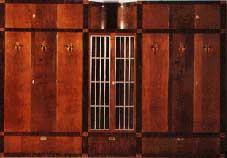
Josef Hoffmann,
A cabinet inlaid with various woods with alpaca handles
TWO THIRDS OF ART DECO BUYERS ARE AMERICANS
Two buyers of Art Deco furniture ad objects are Americans who can afford to pay top prices for important pieces. Art Deco simply appears to more trendy in the United States where modernistic styles are much in favour.
All the more Art Deco furniture and objects were produced over a short period of time which did not exceed 20 years. Important pieces are therefore not easily available on the market.
Art Deco has much to with the American way of living and in the past 10 years U.S buyers have multiplied and acquired pieces produced by the best-known designers at prices ranging from US $ 30,000 to up to US $
1 million. In this respect, European collectors cannot really compete and are only active regarding pieces of furniture and objects sold between US $ 2,000 and 45,000 and only a few can pay up to US $ 100,000.
In Paris, there are over 50 galleries specialising in Art Deco the most famous being Jacques de Vos, rue Bonaparte, Makassar-France in the Louvre des Antiquaires and rue du Faubourg Saint-Honoré, Néo Senso and Félix Marcilhac, rue Bonaparte, Vallois and l'Arc en Seine, rue de Seine, Dutko, also rue Bonaparte and Doria, rue de Seine, Fourtin, place de Valois, Dumonteil, rue de l'Université among others.
The main Parisian experts are Anne-Sophie Duval, quai Malaquais, Félix Marcilhac, rue Bonaparte and Jean-Marcel Camard, rue de la Grande-Batelière whereas the main museums exhibiting Art Déco furniture and objects are the Musée d'Art Moderne, avenue du Président Wilson, le Musée des Arts Décoratifs, Palais du Louvre, the Musée Bourdelle, rue Antoine Bourdelle, the Musées des Années 30, 26 ave Morizet in Boulogne (due to open at the end of 1998) and the Musée des Arts d'Afrique et d'Océanie, avenue Daumesnil. Adrian Darmon
Art Deco has been shining in Paris for the past ten years and the sale of the Pierre Hebey collection on October 28th 1999 has brought proof of the healthy position held by the French capital.
The Pierre Hebey sale was announced as a great event and met all expectations as it realised a turnover of 49 million francs (US $ 8 million) and recorded a new world record price for Jacques-Emile Ruhlmann.
A hairdressing piece of furniture in ebony inlaid with ivory by Ruhlmann sold for
3 800 000 FF (US $ 612,900) (Exclusive of buyer premium), a new world record price.
Most of the 54 Ruhlmann pieces offered for sale were of exceptional quality and quite rare on the market and many major buyers had come to Paris to try to get hold of these bidding against the Makassar, Valois and Arc en Seine Parisian galleries.
For the first time in Paris the Million-Robert group organised its sale in the same way as Sotheby's and Christie's with bidders registering beforehand and equipped with numbered paddles.
A Macassar wood commode fetched 3 400 000 FF (US $ 548 300) (Exclusive of buyer premium) while a magnificent table called Lorcia, created for the actress Gabrielle Lorcia with an airplane wing like top went for 3000 000 FF (US $ 483,870) (Exclusive of buyer premium).
A Mahogany book stand called «Sulzer» sold for 2 200 000 FF (US $ 354,800)
(Exclusive of buyer premium) while a «Maharadjah» deck-chair, which was listed as a national treasure and therefore not allowed to leave France, went for
2 100 000 FF (US $ 338,700). Two «Van Beuningen» window cases with lighting equipment sold for 1 700 000 FF and 2000 000 FF respectively (US $ 274,190 and 322,580) while other Ruhlmann pieces of furniture sold between 950 000 FF and 1 600 000 FF.
An egg-shell lacquered Ruhlmann and Jean Dunand 139 cm high standard lamp sold for 2 500 000 FF (US $ 403,225) (Exclusive of buyer premium).
On October 28th 1999, the PIASA group sold various porcelain vases produced by the Sèvres manufacturing factory between 1880 and 1930. These pieces came from the collection of Martine de Cervens, an American specialist living in London.
A Ruhlmann monumental 52 cm-high vase called «Fountain» and decorated by Maurice Gensoli fetched 430 000 FF (US $ 69,350) (Exclusive of buyer premium). Another Ruhlmann vase with pink cactus flowers went for 120 000 FF (US $ 19,350) while a vase by Prou with a decor representing jockeys also sold for 120,000 FF.
|
|
|
|